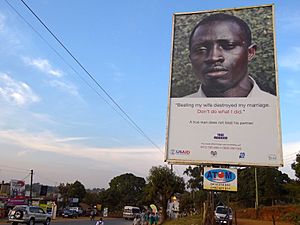Domestic violence facts for kids
Domestic violence means that in a close relationship, like a marriage or partnership, one person uses harmful actions or words to control or hurt the other. This can involve physical harm, like hitting, or emotional harm, like constantly putting someone down. It's about one person trying to have power over the other.
These harmful actions often follow a pattern and can get worse over time. Every community has different ideas about what is right or wrong in relationships. Most countries have laws to protect people who are hurt in these situations. There are also many organizations that can offer help and support.
Sometimes, domestic violence is not reported to the police. This means many people who are affected might not get the help they need right away.
Contents
Understanding Domestic Violence
Domestic violence is a serious problem that affects many people around the world. It is not just about physical harm. It can also be about emotional abuse, where someone uses words or actions to make another person feel bad, scared, or worthless. This kind of abuse can be just as damaging as physical harm.
What Does It Look Like?
Domestic violence can show up in different ways.
- Physical abuse: This is when someone uses their body to hurt another person. It can include hitting, kicking, pushing, or shaking.
- Emotional abuse: This involves words or actions that hurt someone's feelings or self-worth. Examples include yelling, insulting, threatening, or constantly criticizing. It can also be isolating someone from their friends and family.
- Controlling behavior: This is when one person tries to control every part of another person's life. They might control money, what someone wears, or who they can see.
It's important to remember that none of these actions are ever okay. Everyone deserves to feel safe and respected in their relationships.
Why Does It Happen?
There are many reasons why domestic violence happens, but it is never the fault of the person being hurt. Sometimes, people who cause harm might have learned these behaviors from their own past experiences. They might struggle with anger or have difficulty managing their feelings. However, these are not excuses for hurting others.
In some cultures, old beliefs might make it seem like it's okay for one person to control another. But these beliefs are harmful and do not support healthy relationships.
Getting Help and Support
If you or someone you know is experiencing domestic violence, it's important to know that help is available. You are not alone, and it's never too late to seek support.
- Talk to a trusted adult: This could be a parent, teacher, counselor, or another family member.
- Contact a helpline: Many organizations offer free and confidential helplines where you can talk to someone about your situation. They can provide advice and connect you with local resources.
- Know your rights: In most places, there are laws against domestic violence. These laws are designed to protect victims and hold abusers accountable.
Remember, asking for help is a sign of strength. Everyone deserves to live in a safe and loving environment.
Related pages
- Cycle of abuse (patterns in relationships where there is domestic violence)
Images for kids
-
Anti-dowry poster in Bangalore, India
-
The Ottawa Women's Monument, in Minto Park, downtown Ottawa, Ontario, Canada, to the women murdered as a result of domestic violence; dedicated in 1992.
-
Children in Solomon Islands watch a play on gender-based violence.
See also
 In Spanish: Violencia doméstica para niños
In Spanish: Violencia doméstica para niños








